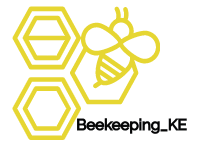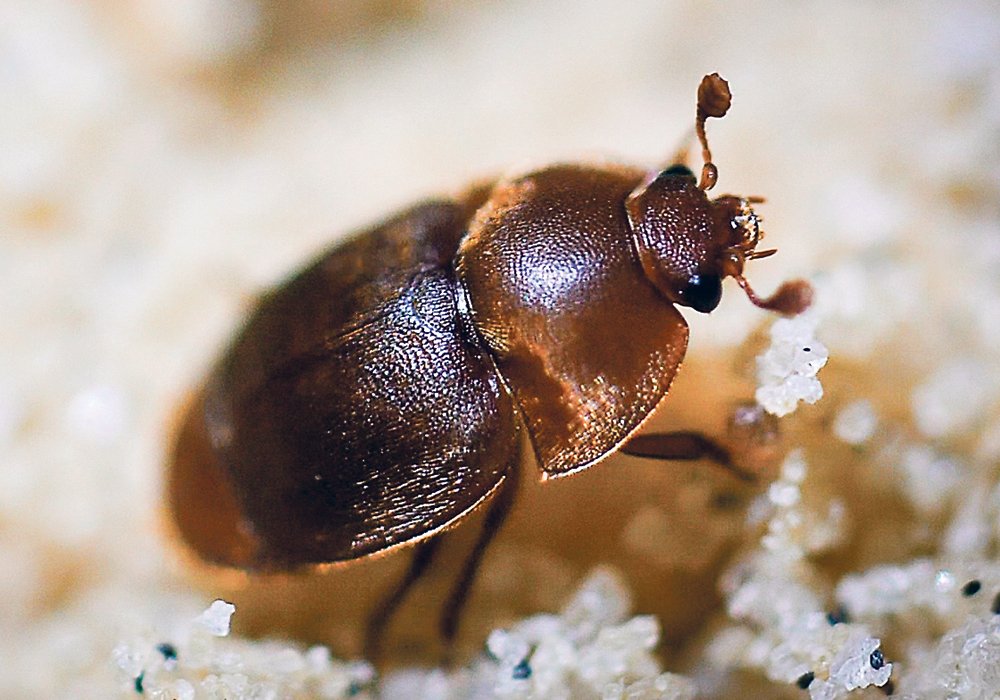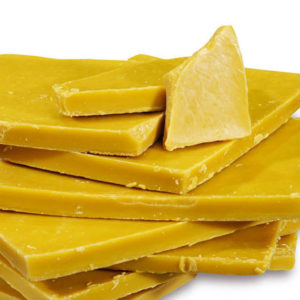Scientifically known as Aethina tumida, the small hive beetle (SHB) is an invasive pest of bee hives. Originally from sub-Saharan Africa, the beetles inhabit a multitude of honey bee colonies in this native range. They are rarely considered as serious bee predators and this owes to the fact that they do little damage to strong healthy colonies.
Honey bee colonies are often able to contend with fairly large populations of adult beetles with minimal effect. High beetle populations however, are able to lay a lot of eggs which rapidly develop and result in the destruction of unprotected combs with a short span of time.
The ability of a small hive beetle population to devastate a bee colony is dependent on a host of factors notably colony strength and the overall colony health. Maintaining strong honey bee colonies keeps the adult beetle population to a minimum and suppresses the beetles’ reproductive potential.
General Appearance of the Small Hive Beetle
Adult Small Hive Beetles are about a quarter inch in length, with an oblong or oval shape, and with varied colors ranging from tan to reddish brown, dark brown or black. They are covered in fine hairs but their size and appearance can be highly variable within a population. Adult SHB are usually observed in the hive with their heads tucked beneath the thorax and thus their antennae and legs are often not apparent.
The larvae are elongated, cream-colored to slightly golden that grow to around half an inch and may be mistaken for the wax moth larvae.
Adult beetles have a hard shell which makes them resistant to bee stings. This makes it hard for honey bee colonies to efficiently remove adult beetles. Rather, the bees are observed to pursue adult beetles across the combs. Beetles seek cracks and crevices within the hive to escape the bees and thus end up trapped. The beetles have developed the ability to simulate the mouth parts of worker bees with their antennae and are thus able to trick their guards into feeding them. This adaptive behavior allows them to survive in confinement for extensive periods.

Life Cycle
Sometimes, the SHB population can increase rapidly especially in the wake of declining bee population. This is often the case during swarming season or due to weakening colony health. During swarming season, the number of bees available to patrol the interior of the hive is reduced allowing the beetle population to surge. Over-supering hives provides beetles with excessive space in which to move and hide. This also provides additional oviposition sites while increasing the area that worker bees must patrol.
Adult female beetles lay egg masses in cracks and crevices around the hive, or directly on pollen and brood combs. They may puncture the capping of a brood cell and deposit eggs inside of it. A single female beetle can produce eggs to the tune of thousands within her lifetime. The eggs hatch in 2-4 days and the larvae immediately begin to feed on pollen, honey, and bee brood.
Beetle larvae complete their development in 7-10 days and will exit the hive to pupate in soil. The larvae burrow up to 10cm into the soil where they remain for 3-6 weeks to complete pupation. Within a day or two of emerging from soil, adult beetles seek out a host honey bee colony. They locate the colony by odor. The adults are strong fliers and can disperse to bee hives easily.

Impact
Damage from the SHB occurs when the honey bee population within a colony is insufficient to protect the honey combs from scavenging beetle larvae. Adult beetles may go unnoticed when they invade a bee colony for the first time. This may be so until their population increases through reproduction or immigration. Both adult and larval beetle prey on honey bee eggs and brood.
When large numbers of beetle eggs hatch in weak colonies, honey combs become “wormy” and take on a glistening, slimy appearance. Adult beetles defecate in honey. When they do so in large numbers, they introduce yeast causing honey to ferment and run out of the cells. When this is the case, the queen bee may stop laying, and the entire colony may abscond.
Beetles can create sudden problems when supers of honey are left virtually unattended by bees. If honey is removed from the hive but not immediately extracted, beetles can invade the honey and ruin a large portion of a honey harvest. Wet capping from recently extracted honey are very attractive and susceptible to beetle infestation.
Honey contaminated by Small Hive Beetle will be rejected by bees and is entirely unfit for human consumption. Contaminated honey should not be bottled or mixed with other honey for packing.


Detection
SHB are easily detected by visual inspection of colonies. They may be observed running across the underside of the outer cover, on either side of the inner cover, or on the top bars of the frames. Strips of corrugated cardboard can be placed on the bottom board at the rear of the hive. Adult beetles, fleeing from bees, may seek shelter in the small spaces of the corrugations and can be easily seen.
The beetle larvae are often found clustered together in corners of a hive or on frames. Surfaces of comb that appear slimy, or fermented honey bubbling from the combs are positive signs of beetle activity. The odor of fermented is honey is described as that of decaying oranges.

Photo credit: Bruce Schalcher
Management of Small Hive Beetle
Prevention is the most effective management strategy of SHB. Chemical controls are available, but are of limited use.
Proper beekeeping management strategies in apiaries are sufficient to contain SHB. Practices that keep bee colonies healthy and strong, reduce stresses from diseases, and mite parasitism go a long way in keeping SHB at bay. Maintenance and propagation of bee stocks with hygienic traits that are better able to detect and remove pests and diseased brood is highly advised.
Caution should be used when combining colonies or exchanging combs and hive bodies. This is because beetles and their eggs can be introduced into other colonies. Hive splitting of heavily infested colonies can cause a serious outbreak. This will be so if insufficient numbers of bees remain to protect a split hive. Over supered hives are also at risk of heavy infestation since the areas that bees have to patrol is increased.
Apiaries should be kept clean to reduce attraction of beetles. Burr comb should be tossed far away from the hive to avoid attracting pests. Adult beetles prefer shady locations. Placing hives in an area that receives direct sunlight at least part of the day will minimize beetle attacks. Regular cleaning or use of screen bottom boards prevents build up of debris that can act as a pupation site for beetle larvae.
Wax capping are an attractive source of food for SHB and should therefore be processed promptly or stored in sealed containers. Honey supers can be temporarily removed from weak colonies to reduce the territory of combs that bees must patrol. Pollen traps should not be left on heavily infested hives for extended periods. Unprotected pollen can double up as a substantial protein source of protein for the beetles and a protected breeding site.
Mechanical traps
Mechanical traps have been used to eliminate SHB in infested hives. Most of these traps kill beetles by drowning them in vegetable or mineral oil. The traps have small openings that allow beetles to enter as they seek shelter, but restrict the relatively larger honey bees.




 Beeswax Block
Beeswax Block